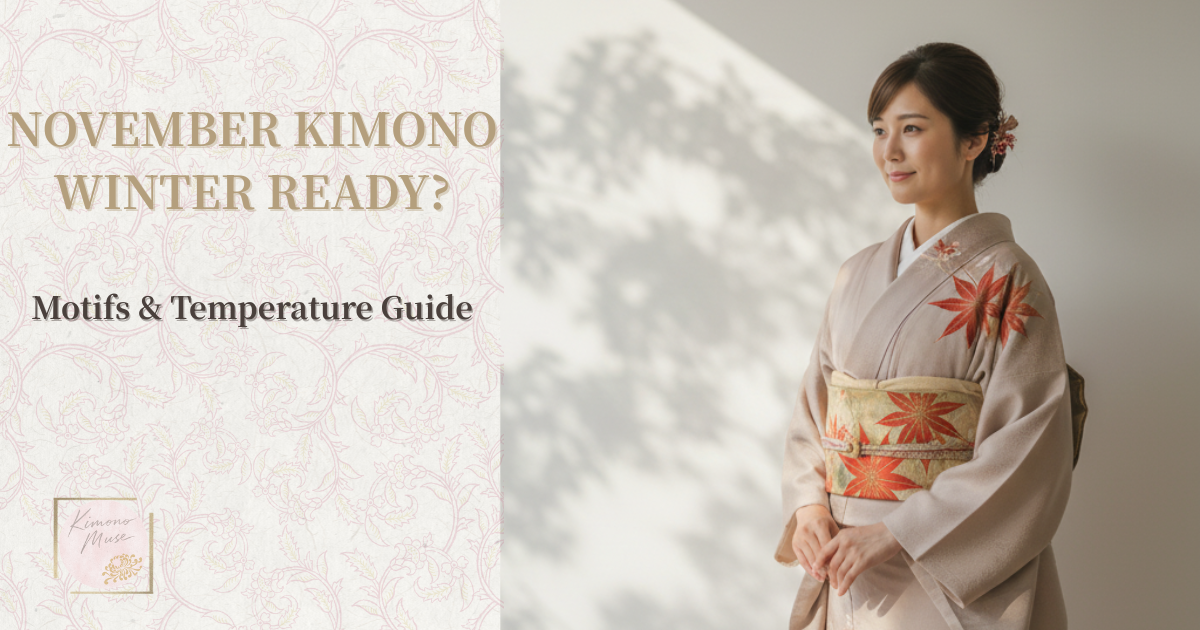Welcoming Winter: November Kimono Coordination and Seasonal Motifs
As the maple leaves turn crimson and the air grows crisp and clear, November marks the true beginning of the season for awase kimono — those with a full lining.
Yet this in-between time, when late autumn slowly shifts toward early winter, often brings a little dilemma:
“Is it too late for autumn motifs?”
“Too early to wear winter patterns?”
With chilly mornings and evenings, layering becomes part of the joy — a haori, a shawl, or another elegant outer layer to complete your look.
In this article, we’ll explore how to choose colors and motifs that beautifully reflect the subtle seasonal transitions of November.
Recommended Color Palette for November
The air in November still carries a trace of autumn’s warmth, yet begins to take on the cool clarity of winter.
This is the perfect season for colors that balance richness and calm, with just a touch of brightness or elegance to lift the mood.
For example:
– Deep crimson or persimmon orange that echoes the lingering autumn leaves
– Subtle shades like ainezu (grayish indigo) or usuzumi (soft charcoal) that hint at the coming winter
– Gentle hues such as flax beige or pale golden brown that bridge the changing seasons
These tones are easy to incorporate into obi and accessories, bringing a refined harmony to your whole ensemble.
Let the tranquil hues of late autumn gently color your style — and warm your heart as the season turns.
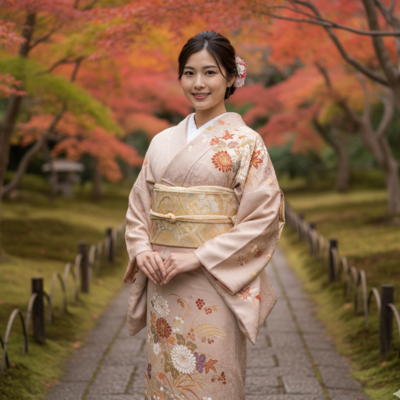
A soft beige-pink hōmongi kimono beautifully complements the glow of late-autumn foliage.
The gold-threaded obi catches the gentle autumn light, adding a refined touch of elegance to the ensemble.
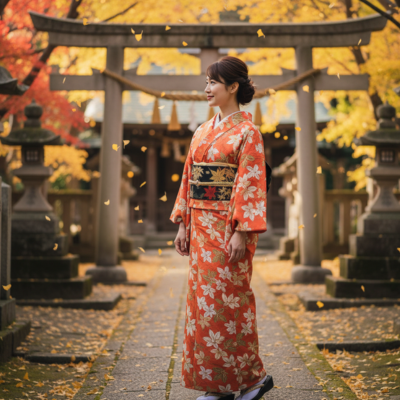
Stroll through a shrine in autumn light with a bright orange komon kimono.
A black obi adds a graceful contrast, bringing balance and depth to the vivid seasonal colors.
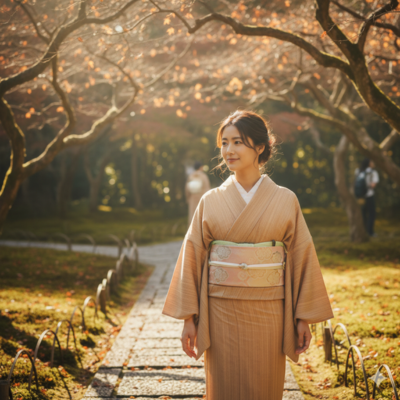
A flax-colored tsumugi paired with a pale obi — a look that gently bridges late autumn and early winter.
Bathed in the soft afternoon light, it creates a calm and warmly elegant impression.
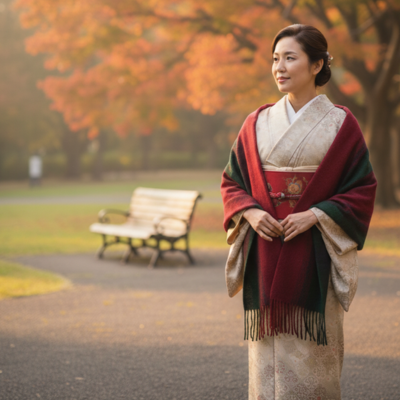
Wrap yourself in a deep crimson shawl to bring warmth to your late-autumn ensemble.
Its gentle color adds a soft accent to an afternoon spent among fallen leaves in the park.
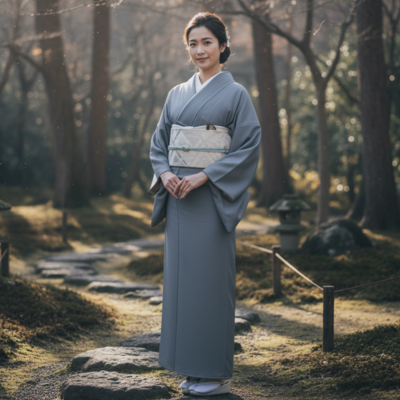
An iromuji kimono in ainezu—a calm grayish indigo—captures the quiet entrance to winter.
A silvery white obi enhances its refined and graceful presence with a touch of serene elegance.
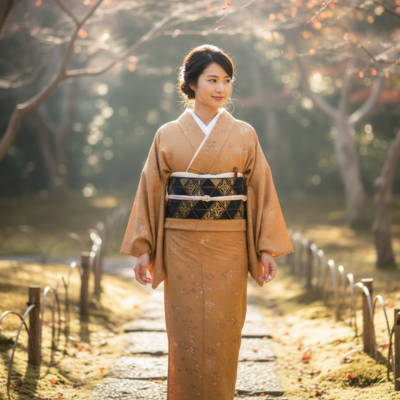
A light golden-brown tsumugi paired with a black obi captures the gentle glow of late autumn.
Wrapped in the soft afternoon light, it creates a calm and tender impression.
Recommended Motifs for November
 Chrysanthemum — Symbol of Longevity and Prosperity
Chrysanthemum — Symbol of Longevity and Prosperity
The chrysanthemum, once celebrated during the Chōyō no Sekku (Chrysanthemum Festival), symbolizes longevity and prosperity.
Realistic chrysanthemum motifs are most suitable for kimono worn in October and November,while more stylized designs can be enjoyed throughout the year.
 Maple Leaves — The Quintessential Motif of Autumn
Maple Leaves — The Quintessential Motif of Autumn
Maple leaves are one of the most iconic autumn motifs, glowing beautifully in November at their peak.Designs vary widely — from Tatsutagawa, where maple leaves drift along flowing water,to Sakura-kaede, where cherry blossoms and maples appear together,and patterns that pair green maples with turning red ones to express the beauty of seasonal change.
 Tatsutagawa — Flowing Water and Autumn Leaves
Tatsutagawa — Flowing Water and Autumn Leaves
A classic design that combines maple leaves with flowing water, Tatsutagawa symbolizes the deepening of autumn.Among maple motifs, it is especially fitting for the month of November.
 Winter Peony (Kan-botan) — Grace Amid the Cold
Winter Peony (Kan-botan) — Grace Amid the Cold
Blooming proudly even in the chill of winter, the peony is admired as a symbol of endurance and noble beauty.Its form remains dignified even under a blanket of snow, embodying quiet strength and elegance.
From November through the New Year, kan-botan motifs add a touch of winter brilliance to kimono style.Deep crimson or pale pink peonies bring refined charm to hōmongi and iromuji alike.
 Snowflake (Yukiwa) — A Symbol of Purity and New Beginnings
Snowflake (Yukiwa) — A Symbol of Purity and New Beginnings
The yukiwa, or snowflake motif, is one of the most iconic patterns of winter.
It represents purity and fresh beginnings, expressing the serene beauty of the cold season.
Used in kimono or obi of white, pale blue, or silvery tones, it creates an elegant and graceful winter look.Wearing it from November as a subtle nod to the coming season is a charming and refined choice.
 Camellia (Tsubaki) — A Symbol of Grace and Quiet Strength
Camellia (Tsubaki) — A Symbol of Grace and Quiet Strength
With its glossy petals and deep green leaves, the camellia is a flower that beautifully represents winter.
Its meanings — “modest kindness” and “pride” — reflect its serene yet dignified charm.
Although tsubaki is typically associated with the months of December through February,
wearing its motif from November gently bridges the seasons.When featured on tsumugi or komon, camellia designs create an elegant, warm impression.
 Karesansui — The Art of Tranquility and Balance
Karesansui — The Art of Tranquility and Balance
Karesansui, or Japanese dry landscape gardens, express the beauty of nature without using water.Flowing patterns in the sand represent streams or waves, while the stones symbolize mountains or islands —a poetic embodiment of stillness and harmony.
Though this motif can be worn year-round, it pairs especially well with the calm tones of late autumn and winter.
When combined with gray or golden-sand accessories or obi, it creates a look that conveys quiet depth and refined serenity.
Featured Motif: Maple Leaves
When people hear “kimono with maple leaf motifs,” many assume it’s something to be worn only during the autumn foliage season in November.
Of course, wearing such designs while the leaves are turning is delightful —
but in the world of kimono, anticipating the coming season is considered the height of elegance.
Adding a touch of autumn to your outfit before the leaves begin to change is a stylish way to enjoy the season.
But did you know that maple patterns aren’t always limited to autumn?
Depending on the design, some can be worn in spring or even all year round.
Here’s a simple guide to help you tell the difference.
① Autumn-Only Designs: Maple Leaves Alone
Patterns featuring only colored maple leaves — or combined with flowing water in the classic Tatsutagawa motif —
are meant to capture the depth of autumn.
The more realistic the depiction, the stronger the seasonal impression, making these perfect for late autumn wear.
② Suitable for Both Spring and Autumn: Green Maples + Red Maples
If your kimono features both green and red maple leaves, it’s expressing the transition of the seasons.
Such designs can be worn in spring (around May) as well as in autumn,
symbolizing the changing beauty of nature.
③ All-Season Designs: Cherry Blossoms + Maple Leaves
A must-know for kimono lovers is the Ōfūmon motif —
a design that combines cherry blossoms, the symbol of spring, with maple leaves, the emblem of autumn.
It represents the harmony of Japan’s four seasons and is considered an auspicious pattern suitable for year-round wear.
Even with the same maple motif, the season it suits can change depending on the accompanying designs —
isn’t that a fascinating depth of kimono artistry?
Take a look at the maple patterns on your own kimono or obi,
and enjoy coordinating them in tune with the changing seasons.
 Shika-Momiji — Deer and Maple Leaves
Shika-Momiji — Deer and Maple Leaves
The Shika-Momiji motif combines deer with autumn maple leaves, evoking the serene beauty of the season.
In Japanese tradition, deer have long been regarded as symbols of longevity and vitality,
while maple leaves represent the splendor of autumn.
Together, they create a poetic pattern cherished for its graceful expression of nature’s transition and quiet charm.
 Ōfūmon — Cherry Blossoms and Maple Leaves
Ōfūmon — Cherry Blossoms and Maple Leaves
The Ōfūmon motif combines cherry blossoms of spring with maple leaves of autumn, symbolizing the beauty of Japan’s four seasons.
By layering flowers and leaves from different times of year, the design reflects the aesthetic ideal of creating “something even more beautiful through harmony.”
It is often depicted with flowing water patterns such as kanzesui, and is cherished as a versatile motif that can be worn throughout the year.
Cherry blossoms are believed to ward off evil, while maple leaves symbolize success and advancement,making Ōfūmon not only elegant but also an auspicious and meaningful pattern.
 Green Maple and Red Maple (Aokaede + Momiji)
Green Maple and Red Maple (Aokaede + Momiji)
This motif depicts the same maple tree in different seasons —
green maple leaves (aokaede) symbolizing the freshness of early summer,
and red maples (momiji) representing the deep colors of autumn.
When shown together, they express the graceful transition of the seasons.
Because this design bridges spring through autumn,it’s a wonderful choice for those who wish to reflect seasonal change in a subtle, elegant way.
Conclusion
November is a season when kimono fashion becomes especially delightful —
a time to “enjoy autumn leaves” through the motifs you wear.
Designs such as Tatsutagawa, Ōfūmon, and Shika-Momiji take center stage at this time of year.
The key is to embrace these patterns a little earlier than the actual season.
By reflecting the changing colors of nature in your attire — from before the leaves turn to the quiet end of autumn —
you can capture the refined elegance that is unique to kimono style.
Let these motifs inspire you to create your own special November coordination —
a look that celebrates the beauty of the season in every graceful detail.
✿ Column: Fumi’s Kimono Diary ✿
As the air grows cold, the scent of fragrant olive quietly fades away.
Perhaps it is through kimono that I feel the changing seasons most vividly.
At this time of year, while bright maple patterns are lovely,
I find myself drawn instead to gentle shades of brown or ainezu—a soft grayish indigo.
When the light begins to wane, the warmth hidden within the fabric comes alive.
Savoring such subtle changes, I cherish the quiet moments spent choosing an obi.
May this autumn, too, be a season to enjoy the soft sounds of time—together with your kimono.
